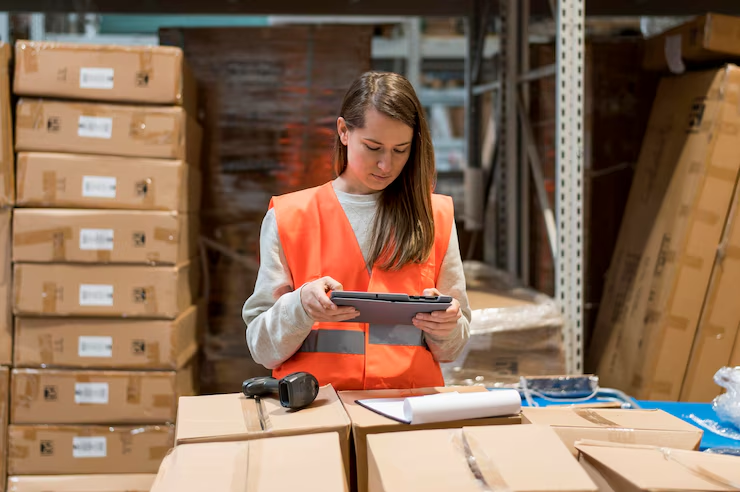When you hear the term “warehousing inventory,” you might picture vast buildings filled with rows of shelves, forklifts humming through aisles, and workers scanning barcodes. And while that image still holds some truth, the reality of modern warehousing inventory management is undergoing a massive technological revolution. From artificial intelligence (AI) to robotics, from IoT (Internet of Things) to predictive analytics, the world of inventory management is transforming at lightning speed.
For anyone passionate about technology, the warehousing sector offers a fascinating playground. In this article, we’ll dive deep into the complexities of warehousing inventory, explore how cutting-edge technologies are reshaping it, and look at where this crucial component of the global supply chain is heading.
The Heart of Warehousing: Inventory Management
At its core, warehousing inventory management is about controlling the flow of goods into, within, and out of a storage facility. It involves tracking stock levels, managing storage space, optimizing picking and packing operations, and ensuring that inventory levels match demand without overstocking or stockouts.
Traditional inventory management relied heavily on manual labor and basic software systems. But the sheer scale and complexity of modern supply chains, driven by e-commerce, globalization, and customer expectations for speed, have pushed the limits of these conventional methods.
The Pain Points of Traditional Warehousing Inventory
To understand why technology is so vital, let’s briefly outline the key challenges that plague traditional warehousing inventory systems:
- Human Error: Manual data entry and paper-based tracking lead to inaccuracies.
- Inefficiency: Workers spend significant time searching for items or correcting mistakes.
- Lack of Visibility: Limited real-time data makes it difficult to monitor inventory status.
- Inflexibility: Difficulty adapting to sudden changes in demand or supply disruptions.
- High Operating Costs: Labor-intensive processes drive up costs and reduce margins.
These pain points create a perfect storm that technology is uniquely positioned to resolve.
The Technology Powering Modern Warehousing Inventory
Let’s break down the core technologies that are revolutionizing warehousing inventory management today.
1. The Rise of Warehouse Management Systems (WMS)
The foundation of any modern warehouse operation is a robust Warehouse Management System. A WMS is essentially a software platform that integrates every aspect of inventory management. From receiving goods to shipping them out, a WMS offers end-to-end visibility and control.
Key features of advanced WMS include:
- Real-time inventory tracking
- Automated reorder alerts
- Location optimization algorithms
- Integration with enterprise resource planning (ERP) systems
- Performance analytics and reporting
By automating repetitive tasks and centralizing data, WMS drastically reduces human error and increases operational efficiency.
2. Internet of Things (IoT) in Warehousing Inventory
Imagine tiny sensors attached to every pallet, shelf, and vehicle within a warehouse. These IoT devices collect real-time data on inventory levels, temperature, humidity, and even equipment status.
IoT transforms warehousing inventory by:
- Providing real-time stock visibility
- Monitoring environmental conditions for sensitive goods
- Predicting maintenance needs for machinery
- Enhancing worker safety through wearable tech
For example, a cold storage warehouse handling pharmaceuticals can use IoT sensors to maintain precise temperature conditions, instantly alerting managers if any anomaly occurs.
3. Robotics and Automation
Warehouse robotics is no longer science fiction. Companies like Amazon have popularized the use of autonomous mobile robots (AMRs) that zip around warehouses, picking and transporting items with precision.
Key types of warehouse robots include:
- Automated guided vehicles (AGVs)
- Collaborative robots (cobots) that work alongside humans
- Robotic arms for picking and sorting
These robots increase speed, reduce labor costs, and improve safety by taking over repetitive, physically demanding tasks.
4. Artificial Intelligence (AI) and Machine Learning (ML)
AI brings intelligence to warehousing inventory. Machine learning algorithms analyze historical data to identify patterns, optimize inventory levels, and forecast demand more accurately than any human could.
AI-driven capabilities include:
- Predictive demand forecasting
- Dynamic slotting (optimal placement of items for faster picking)
- Anomaly detection for shrinkage or theft
- Real-time decision support for managers
For example, during peak holiday seasons, AI can predict which products will be in high demand and automatically adjust inventory levels and warehouse layouts to maximize efficiency.
5. Cloud Computing and SaaS Solutions
Cloud-based warehousing inventory solutions offer scalability, flexibility, and accessibility. With data stored securely in the cloud, stakeholders can access real-time inventory information from anywhere in the world.
Benefits of cloud solutions include:
- Lower upfront costs compared to on-premise systems
- Seamless software updates and feature enhancements
- Easy integration with other business systems
- Enhanced data security and disaster recovery capabilities
Cloud platforms also enable smaller companies to access powerful tools that were once only affordable for large enterprises.
How These Technologies Work Together
Individually, each of these technologies offers significant benefits. But the real magic happens when they converge into a unified, intelligent ecosystem.
Imagine this scenario:
A shipment arrives at a warehouse. IoT sensors automatically log the arrival and update the WMS. The WMS, integrated with AI algorithms, immediately determines the optimal storage location based on current inventory levels, predicted demand, and picking efficiency. Autonomous robots transport the goods to their assigned slots. All this happens with minimal human intervention, while managers monitor operations in real time via a cloud-based dashboard accessible from any device.
This level of orchestration turns warehousing inventory into a highly adaptive, self-optimizing system that can respond to changes in supply and demand almost instantly.
The Role of Predictive Analytics in Inventory Management
Predictive analytics takes warehousing inventory to another level by leveraging big data. By analyzing historical trends, customer behavior, seasonality, and external factors (such as weather or geopolitical events), predictive models can forecast demand with incredible accuracy.
Benefits include:
- Reduced stockouts: Prevent running out of high-demand items.
- Lower carrying costs: Avoid overstocking slow-moving products.
- Improved cash flow: Better inventory turnover ratios.
For example, a retailer using predictive analytics might notice that certain electronics spike in demand during back-to-school season. The system can automatically ramp up orders months in advance, ensuring stock availability when customers start shopping.
The Impact on Supply Chain Resilience
The COVID-19 pandemic exposed vulnerabilities in global supply chains, emphasizing the need for resilience and flexibility. Advanced warehousing inventory systems play a critical role in this transformation.
With real-time data, predictive analytics, and automation, warehouses can quickly adapt to disruptions by:
- Rerouting shipments
- Shifting inventory between locations
- Prioritizing essential goods
- Adjusting labor allocation dynamically
This agility minimizes downtime and helps maintain service levels even during crises.
The Human Element: Technology as an Enabler, Not a Replacement
One common fear surrounding automation and AI is job displacement. But in the context of warehousing inventory, technology often serves as an enabler rather than a replacement for human workers.
While robots handle repetitive, physically demanding tasks, humans take on more skilled roles such as:
- System oversight and troubleshooting
- Data analysis and decision-making
- Customer service and exception handling
- Continuous process improvement
The result is a safer, more engaging work environment where technology amplifies human capabilities.
Real-World Examples of Tech-Driven Warehousing Inventory
Amazon’s Robotic Fulfillment Centers
Amazon’s warehouses are perhaps the most famous example of integrated technology in warehousing inventory. Their Kiva robots autonomously transport shelves to human pickers, drastically reducing picking time and increasing order accuracy.
Ocado’s AI-Powered Grocery Warehouses
Ocado, a British online grocery retailer, operates highly automated fulfillment centers where thousands of robots move across a grid system, picking and packing orders with astonishing speed. AI algorithms optimize every movement in real-time.
DHL’s Smart Warehouses
DHL has implemented wearable technology, AI-powered analytics, and autonomous robots across many of its global warehouses. This has resulted in improved productivity, reduced errors, and higher customer satisfaction.
The Road Ahead: Emerging Technologies in Warehousing Inventory
The pace of innovation shows no sign of slowing. Here are some emerging trends that will shape the future of warehousing inventory:
Digital Twins
Digital twins create a virtual replica of the physical warehouse, allowing managers to simulate different scenarios and optimize operations before implementing changes in the real world.
Blockchain for Supply Chain Transparency
Blockchain can enhance traceability and security in warehousing inventory by creating immutable records of product movements and transactions.
5G Connectivity
The rollout of 5G networks enables faster, more reliable communication between IoT devices, robots, and cloud systems, unlocking new levels of real-time coordination.
Augmented Reality (AR) for Training and Operations
AR headsets can guide warehouse workers through complex tasks, reduce training time, and improve picking accuracy by overlaying digital instructions onto the physical environment.
Conclusion: The Future is Now
Warehousing inventory management is no longer just about storing goods; it’s about orchestrating a complex symphony of people, processes, and technologies. The integration of AI, IoT, robotics, and cloud computing is creating smarter, more resilient warehouses capable of meeting the demands of a fast-paced, unpredictable global economy.
For technology enthusiasts, this is an exciting frontier where innovation directly impacts the physical world, making supply chains more efficient, sustainable, and responsive. As these technologies continue to evolve, the warehouses of the future may bear little resemblance to those of today—except for one thing: the constant drive for greater efficiency and customer satisfaction.
In the world of warehousing inventory, the future isn’t coming. It’s already here.


https://shorturl.fm/jyo7w
https://shorturl.fm/coMjV